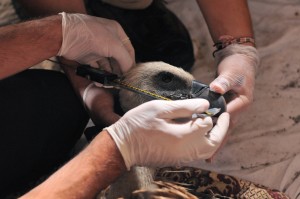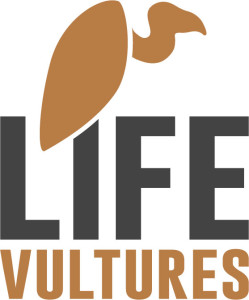Ten griffon vultures (nine adults and one juvenile) in Bulgaria’s Rhodope Mountains were fitted with satellite transmitters at the end of May. These will provide critical data on the distribution, migration and possible threats to the birds, enhancing conservation of the species in the region.
The transmitters were fitted as part of the LIFE Vultures Project by a seven-strong team from the Bulgarian Society for the Protection of Birds (BSPB). Over a two-day period, the team also fitted the birds with colour rings and numbered wing tags, enabling easier and quicker identification, and collected blood and biological samples. These samples will be sent to specialised laboratories in Europe, and should provide valuable insight into the health of each vulture.
The BSPB researchers, who are part of the Rewilding Rhodopes team, are already receiving signals from the newly fitted transmitters. These send information about the location of each vulture every 10 minutes.

“The results of this research will allow us take specific measures to help the vulture population survive and grow,” says Volen Arkumarev, LIFE Vultures Project Conservation Officer. “These include the insulation of dangerous power lines, controlling the use of poison through our specialised dog unit, and identifying suitable places for supplementary feeding.”
The aim is to eventually fit 20 griffon vultures and a similar number of black vultures with transmitters. Last year seven griffon vultures (four adults and three juveniles) were fitted with satellite transmitters in a breeding colony near Madzharovo in the Bulgarian Rhodope Mountains rewilding area, while eleven black vultures were also tagged in Dadia National Park in northern Greece.
The transmitters fitted last year have already supplied valuable data on vulture migration – this will soon be made available online via the project website. Arda, a young griffon vulture, was seen to have undertaken a long journey to the southeast of Bulgaria. Flying across two continents and six countries, the bird ranged across the Middle East and southeastern Europe.

Another young griffon vulture fitted with a transmitter, marked for research and monitoring purposes as Zvezdi, demonstrated his strength of character in front of a wildlife photographer. Previously rescued from drowning in the cold waters of the Studen Kladenets Reservoir, the bird was captured on camera defeating an eagle in an unequal battle for food. Zvezdi’s transmitter sadly stopped working just two months later, showing how critical the first year is for the survival of young vultures.
Read more about the rewilding activities carried out as part of the LIFE Vultures Project, which is co-funded by the Fondation Segré, here.
